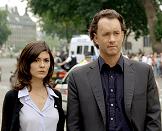 “The Da Vinci Code” movie, like the novel it’s based on, is ridiculous, obvious, over-the-top–and yet oddly compelling, a guilty pleasure that wraps interesting pseudohistory and pseudotheology into a shoot-’em-up thriller. In other words, if you liked the book, you’ll probably like the movie. Ditto if you hated or were offended by it. As the critics have their field day hurling insults at the movie, it’s hard not to see “Da Vinci” as a victim of unrealistic expectations. Say what you will about the book, but it is anything but subtle or plausible, and the movie follows suit. Watching the story on film, the absurdities of the plot and campiness of the dialogue are heightened, but I’m not sure why anyone would be surprised by that.
“The Da Vinci Code” movie, like the novel it’s based on, is ridiculous, obvious, over-the-top–and yet oddly compelling, a guilty pleasure that wraps interesting pseudohistory and pseudotheology into a shoot-’em-up thriller. In other words, if you liked the book, you’ll probably like the movie. Ditto if you hated or were offended by it. As the critics have their field day hurling insults at the movie, it’s hard not to see “Da Vinci” as a victim of unrealistic expectations. Say what you will about the book, but it is anything but subtle or plausible, and the movie follows suit. Watching the story on film, the absurdities of the plot and campiness of the dialogue are heightened, but I’m not sure why anyone would be surprised by that.
Though the film is too long and doesn’t always have the fast-paced feel of the novel, Ron Howard’s film is unlikely to sway any minds in the debate over the story’s attitudes and allegations about Christianity. The faith–traditional Christian beliefs and their development–comes off ever-so-slightly better on screen than in the novel. Robert Langdon, the hero-professor at the center of the story, here is given a moment of true faith, and in a possible bone to critics, makes an attempt to bridge the worlds of skepticism and faith that are at war in the story. In streamlining the characters’ long theological discourses, screenwriter Akiva Goldsman focuses on Mary Magdalene and the supposed ramifications of her suppression in the early church, and discards most of the talk about the feminine divine, Christianity’s pagan roots, and rituals of sensuality and sexuality allegedly eliminated by church leaders.
As for the church–the people, the institution–the opposite is true. Vatican leaders are more deeply involved in the murderous plot than in book, and the accusations leveled at the church, of suppression (both of the violent and theological varieties) are sharp. In flashback scenes that are too cartoonish not to provoke unintended laughter, director Ron Howard dramatizes the Crusades and the Knights Templar, along with the Inquisition and other moments of Christian violence, emphasizing the brutality of the church’s actions.
There was a moment in “The Da Vinci Code” that reminded me of the last movie to have touched a cultural nerve this deeply. Though the two are as different as can be in content and intention, both “The Passion of the Christ” and “Da Vinci” offer scenes of salacious, graphic, needless mutilation–the first when Jesus’ skin is flayed by Roman guards, the second when the murderous Opus Dei monk Silas beats himself ritually and the camera lingers on his injured body. I doubt the connection was intentional, and am not saying there’s any thematic connection between the two films. But thinking of both these scenes–and both these movies–is a reminder of how difficult it is for all but the most masterful filmmakers to depict subtlety and emotional depth on screen; the medium lends itself to the exaggerated and sensational, and neither film rises above that. You may find “Da Vinci” fun and intriguing, or you may find it offensive and upsetting, but either way, you won’t find profundity.


